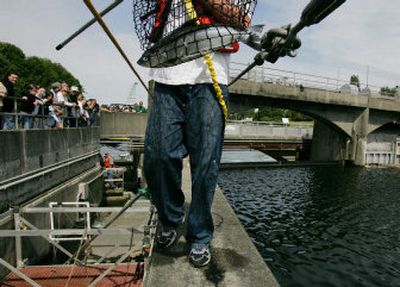Was water too warm for salmon?

SEATTLE – As many as 200,000 sockeye salmon disappeared last year between the Ballard Locks and spawning grounds above Lake Washington. Scientists suspect rising water temperatures could be the culprit.
The signs were there early on. At the Hiram M. Chittenden Locks, which separate Lake Washington and Puget Sound, Mike Mahovlich saw salmon carcasses surface belly-up when water rose in the locks, and dying salmon lay gasping on rocks on the saltwater side.
“In my 15 years there was nothing as bad as last year, as far as just seeing dead bodies of sockeye,” said Mahovlich, a fish biologist for the Muckleshoot Tribe, which helps manage the run.
Then came the startling data from beyond the lake, word that roughly half the run had not made it to spawning streams. Scientists are focusing on abnormal water temperature, worried that climate change could make the higher temperatures a new fact of life.
In the past 34 years, three of the four years with the biggest sockeye decline between the Locks and spawning beds have been since 2000. Recent research shows Lake Washington has warmed over the past 30 years, perhaps due to global warming.
But 2004 was the worst by far, convincing researchers the decline was not a matter of imprecise counts.
When the sockeye began heading through the locks in June 2004, the season looked good. Those counting fish at the locks’ salmon ladder reported high enough numbers that a sockeye fishing season was launched.
Dead salmon began to turn up in significant numbers in August. The state tested some of them for signs of disease but found no indications of a major outbreak.
The magnitude of the problem became clear in October, when the fish were expected at spawning streams.
In Bear Creek, where as many as 40,000 sockeye spawned 25 years ago, just 1,500 arrived.
In the Cedar River, where most of the sockeye usually spawn, scientists waiting for a surge of fish saw only a steady, low flow.
By winter, the hot summer of 2004 and the absence of a disease outbreak led researchers to suspect high water temperatures in the Lake Washington Ship Canal – a narrow, shallow waterway the sockeye must pass through to reach Lake Washington’s cool, deep waters.
Sunny, warm weather last summer pushed the ship canal’s water temperature to 68 degrees on June 21, two weeks earlier than ever recorded. On July 18, it was 71.6 degrees.
Water temperature above 68 degrees is dangerous for salmon, causing stress that makes them more vulnerable to disease. At 77 degrees, the temperature can kill them outright.
Warm water also was suspected in the disappearance of British Columbia sockeye last year. As many as 1.3 million fish failed to make it to spawning grounds on the Fraser River, one of the province’s most important commercial salmon runs. The catastrophe there led to government inquiries.
The Lake Washington disappearance didn’t generate as much controversy, but it is raising concerns about the state of the sockeye, Seattle’s largest salmon run.
Chinook salmon, most of which go through the locks in August, didn’t appear to suffer as much, said Eric Warner, another Muckleshoot biologist. They may not be as temperature sensitive.
The sockeye aren’t native to Lake Washington. They were introduced in the 1930s.
But the fish have cultural and economic importance to the region. The Muckleshoot, Tulalip and Suquamish tribes have harvest rights. A good run draws hundreds of recreational anglers to Lake Washington in July. And tourists visit the locks in hopes of seeing sockeye pass by the big underwater windows.
Tribal and state scientists are preparing studies to try to determine what might be happening to the sockeye.
One study will tag salmon with sensors to measure the water temperatures they are enduring.
Another would use underwater radio receivers to determine how many pass through the ship canal.
Yet another seeks a more accurate count of salmon that make it from the locks to the spawning grounds.
“There’s just a lot of ‘Maybe this is it,’ and guesses,” said Steve Foley, the lead Lake Washington salmon biologist for the state Fish and Wildlife Department. “We’re looking this year to try to get some answers.”
Water temperature remains the prime suspect. Evidence has linked rising air temperatures in the Seattle area to increased surface-water temperatures in Lake Washington. A 2004 study by University of Washington and King County researchers found that average summer surface-water temperatures have risen by about 4 degrees over a 35-year period, with air temperatures the strongest influence.
Last year’s sockeye problems show “exactly why that study is relevant,” said Michael Brett, a University of Washington scientist who co-wrote it.